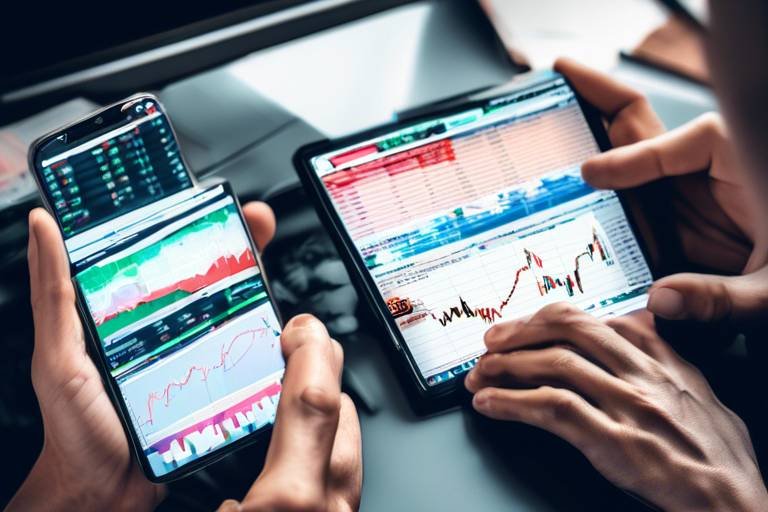How to Conduct Competitive Analysis for Crypto Trading
In the fast-paced world of cryptocurrency trading, staying ahead of the competition is not just a luxury—it's a necessity. With thousands of digital assets available and new trading platforms popping up like mushrooms after rain, how do you make informed decisions that can significantly impact your trading performance? This article dives deep into the essential steps and strategies for conducting a competitive analysis in the crypto trading market. By understanding your competitors and the broader market landscape, you can enhance your trading performance and position yourself for success.
So, what exactly is competitive analysis in the realm of crypto trading? At its core, it involves evaluating your competitors to identify their strengths, weaknesses, opportunities, and threats. Think of it as having a map in an unfamiliar territory; it helps you navigate the complexities of the market. By gathering insights about your competitors, you can better understand where you stand and how to carve out your niche. This foundational knowledge is critical for any trader looking to make strategic moves in a volatile market.
Recognizing who your main competitors are is crucial for any trader aiming to thrive. But how do you pinpoint these players in the crowded crypto space? Start by looking at various categories:
- Exchanges: These are platforms where cryptocurrencies are bought and sold. Understanding the top exchanges can give you insights into market liquidity.
- Trading Bots: Automated trading solutions that can execute trades based on preset conditions. Analyzing their strategies can reveal effective trading techniques.
- Investment Strategies: Different traders have unique approaches. Observing their methods can help you refine your own.
By identifying these key players, you can begin to analyze their strategies and market positioning.
Examining the strategies employed by your competitors can provide valuable insights into market trends and successful practices. What trading techniques are they using? Which assets are they choosing to invest in? And how do they manage risk? By answering these questions, you can uncover patterns that might inform your own trading style. For instance, if a competitor consistently invests in a particular altcoin that is gaining traction, it might be worth your attention.
One of the critical metrics to consider is trading volume. This figure indicates how much of a particular asset is being traded within a specific time frame. High trading volumes often suggest strong interest and liquidity, while low volumes can indicate the opposite. Understanding your competitors' trading volumes can help you gauge market activity and liquidity, allowing you to make more informed decisions.
How do your competitors position themselves in the market? This question can reveal opportunities for differentiation. Key aspects to consider include:
- Branding: How do they present themselves? A strong brand can attract more traders.
- Target Audiences: Who are they catering to? Understanding their audience can help you identify gaps in the market.
- Unique Selling Propositions: What makes them stand out? This could be lower fees, better customer service, or innovative trading tools.
By evaluating these factors, you can find ways to position yourself uniquely in the market.
In the age of technology, leveraging analytical tools can significantly enhance your competitive analysis. There are numerous platforms available that provide valuable data and insights for crypto traders. Some popular tools include:
| Tool | Purpose |
|---|---|
| CoinMarketCap | Provides market capitalization, volume, and price data for cryptocurrencies. |
| TradingView | Offers advanced charting tools and social networking features for traders. |
| Glassnode | Delivers on-chain data analytics for deeper market insights. |
Utilizing these tools can provide you with a competitive edge, allowing you to make data-driven decisions.
In the crypto world, change is the only constant. Continuous monitoring of market trends is vital for effective competitive analysis. Staying informed about industry news, regulatory changes, and technological advancements can help you adapt your strategies in real-time. It’s like surfing; you have to ride the waves of change to stay afloat.
Social media platforms can offer significant insights into competitor activities and public perception. By analyzing social media trends, you can gauge how your competitors are perceived and what strategies resonate with their audience. This insight can guide your own marketing efforts and help you connect with potential traders.
Once your analysis is complete, the real work begins. Adapting your strategies based on the insights gained is essential. This could mean tweaking your trading approach, adjusting your marketing tactics, or even exploring new asset classes. The key is to remain flexible and responsive to the competitive landscape.
Q: Why is competitive analysis important in crypto trading?
A: It helps traders understand the market landscape, identify opportunities, and make informed decisions.
Q: What tools can I use for competitive analysis?
A: Tools like CoinMarketCap, TradingView, and Glassnode are popular for gathering market data and insights.
Q: How often should I conduct competitive analysis?
A: Regular analysis is recommended, especially in a rapidly changing market like crypto. Staying updated helps you adapt to new trends and strategies.

Understanding Competitive Analysis
When diving into the world of crypto trading, understanding competitive analysis is like having a treasure map in a vast ocean of opportunities. It’s not just about knowing what your competitors are doing; it’s about uncovering the hidden gems that can give you an edge in the market. Competitive analysis involves a systematic evaluation of your rivals, allowing you to identify their strengths, weaknesses, opportunities, and threats (commonly referred to as SWOT analysis). This foundational knowledge is crucial for positioning yourself effectively and making informed trading decisions.
Imagine you’re a captain navigating through turbulent waters. Without a clear understanding of the currents (your competitors), you might find yourself lost or, worse, capsized. By conducting a thorough competitive analysis, you can chart a course that not only avoids pitfalls but also takes advantage of favorable winds. This process involves gathering data on various aspects of your competitors’ operations, including their trading strategies, market positioning, and customer engagement tactics.
For instance, let’s say you discover that a competitor is successfully attracting a large audience by offering unique trading tools or educational resources. This insight can inspire you to develop similar offerings or find ways to differentiate your services. The goal is to not just replicate what others are doing, but to carve out your own niche in the market. Here’s a quick breakdown of what to consider during your competitive analysis:
- Market Share: Who holds the largest share of the market?
- Trading Strategies: What approaches are they using to achieve success?
- Customer Engagement: How do they interact with their audience?
- Technological Edge: Are they using any advanced tools or platforms?
By analyzing these factors, you can gain insights that are not just useful but essential for your trading success. Additionally, competitive analysis is not a one-time task; it’s a continuous process. The crypto market is notorious for its rapid changes, and staying ahead means keeping a close eye on your competitors' movements. You’ll want to regularly update your analysis to reflect new developments, market trends, and shifts in customer preferences.
In conclusion, understanding competitive analysis in crypto trading is about more than just collecting data; it’s about transforming that data into actionable strategies. It empowers you to make informed decisions, adapt to changing conditions, and ultimately enhance your trading performance. So, as you embark on your trading journey, remember that knowledge is power, and competitive analysis is your best ally in navigating the unpredictable waters of the crypto market.

Identifying Key Competitors
Identifying your key competitors in the crypto trading space is akin to knowing your rivals in a race. Just like a sprinter wouldn't start a race without knowing who they are up against, a trader must also be aware of the competitive landscape. In the dynamic world of cryptocurrency, where new players emerge almost daily, recognizing who your main competitors are is crucial for strategic positioning and success.
So, how do you go about pinpointing these competitors? One effective method is to start by analyzing the major cryptocurrency exchanges. These platforms are often the first point of contact for traders, and understanding their strengths and weaknesses can provide valuable insights. For instance, exchanges like Binance, Coinbase, and Kraken dominate the market, but each has unique features that appeal to different types of traders. By evaluating their trading fees, user interfaces, and customer support, you can gain a clearer picture of where you might fit into the market.
Another area to consider is the trading bots and automated trading platforms that many traders use. These tools can significantly affect trading strategies and market dynamics. For example, platforms like 3Commas and Cryptohopper offer various automation features that can attract both novice and experienced traders. By analyzing these bots, you can identify which functionalities are gaining traction and potentially adapt your strategies accordingly.
Additionally, it's essential to look at investment strategies employed by other traders. This includes examining the types of assets they are trading, their risk management techniques, and even their marketing approaches. You might find that some competitors focus on high-risk, high-reward assets, while others prefer stablecoins or established cryptocurrencies. Understanding these strategies can help you carve out your niche.
To sum up, identifying key competitors in the crypto trading arena involves a multi-faceted approach:
- Analyze Major Exchanges: Look at the leading exchanges and their offerings.
- Explore Trading Bots: Understand how automated tools influence trading strategies.
- Study Investment Strategies: Examine the assets and techniques competitors are using.
By employing these strategies, you can develop a comprehensive understanding of your competitive landscape. This knowledge not only helps in positioning yourself effectively but also in anticipating market shifts and adapting your strategies accordingly.

Analyzing Competitor Strategies
When it comes to crypto trading, understanding your competitors' strategies can be the difference between making a profit and incurring losses. Think of it like a chess game; knowing your opponent's moves can help you anticipate their next play. By analyzing how competitors operate, traders can uncover valuable insights that can inform their own strategies. This process involves a deep dive into various aspects of their trading techniques, asset choices, and risk management approaches.
One of the first steps in analyzing competitor strategies is to look at their trading techniques. Are they using high-frequency trading, or are they more inclined towards long-term holding? Each method has its own set of advantages and risks. For instance, high-frequency trading may yield quick profits but requires sophisticated algorithms and constant market monitoring. In contrast, long-term holding can be less stressful and allows traders to ride out market volatility.
Next, consider the assets that competitors are focusing on. Are they investing heavily in established cryptocurrencies like Bitcoin and Ethereum, or are they exploring newer, lesser-known altcoins? By identifying the assets that competitors are prioritizing, you can gauge market sentiment and potentially discover lucrative opportunities that others might be overlooking. For example, if a competitor is heavily investing in a particular altcoin, it might be worth investigating why and whether it aligns with your trading goals.
Another critical component to analyze is the risk management strategies that competitors employ. Successful traders often have robust risk management protocols in place to protect their investments. This could include setting stop-loss orders, diversifying their portfolio, or employing hedging techniques. By understanding how competitors mitigate risks, you can refine your own strategies to minimize potential losses.
To further illustrate these points, here’s a table summarizing various competitor strategies:
| Competitor | Trading Technique | Assets Focused | Risk Management Approach |
|---|---|---|---|
| Trader A | High-Frequency Trading | Bitcoin, Ethereum | Stop-Loss Orders |
| Trader B | Long-Term Holding | Altcoins | Diversification |
| Trader C | Swing Trading | Mix of Established and New Coins | Hedging Techniques |
By studying these strategies, traders can identify patterns and trends that may be beneficial to their own trading approach. It’s also essential to keep an eye on how competitors adapt to market changes. For instance, if a new regulation is introduced, how quickly do they adjust their strategies? This adaptability can be a significant indicator of a trader's overall effectiveness in the market.
In summary, analyzing competitor strategies is not just about copying what others do; it’s about understanding the landscape of the crypto market. By examining their trading techniques, asset choices, and risk management practices, traders can make informed decisions that enhance their performance. So, the next time you sit down to trade, remember to consider the moves of your competitors—it could be the secret weapon you need to succeed.

Evaluating Trading Volume
When it comes to crypto trading, trading volume is like the heartbeat of the market. It tells you how much activity is buzzing around a particular cryptocurrency, and understanding it can be a game-changer for your trading strategy. Essentially, trading volume measures the total number of coins that have been traded within a specific timeframe. High trading volume typically indicates strong interest in a cryptocurrency, while low volume can signal a lack of market enthusiasm.
To evaluate trading volume effectively, you'll want to consider several key factors. First, look at the historical volume data. This information can provide insights into the typical trading patterns of a cryptocurrency. For example, if the trading volume spikes suddenly, it may indicate that something significant is happening—like a new partnership announcement or a regulatory change—that could affect the asset's price. Conversely, a sudden drop in volume could signal waning interest or potential issues within the coin's ecosystem.
Another critical aspect to evaluate is the trading volume across different exchanges. Not all exchanges are created equal; some may have significantly higher trading volumes than others. This disparity can influence price movements and market sentiment. For instance, if a cryptocurrency is trading at a high volume on a major exchange, it might indicate that traders are confident in its future, while low volume on smaller exchanges may suggest the opposite.
To illustrate the importance of trading volume, consider the following table that compares the trading volumes of popular cryptocurrencies:
| Cryptocurrency | 24-Hour Trading Volume (in USD) | Market Cap (in USD) |
|---|---|---|
| Bitcoin (BTC) | $30 Billion | $600 Billion |
| Ethereum (ETH) | $15 Billion | $250 Billion |
| Cardano (ADA) | $1 Billion | $35 Billion |
In the example above, Bitcoin has a significantly higher trading volume compared to Cardano, which may suggest that Bitcoin is currently more attractive to traders. However, it’s essential to look beyond just the numbers. Analyzing the context behind the volume can provide deeper insights. For instance, if a coin has a high trading volume but a declining price, it could indicate that traders are selling off their holdings, which might be a red flag.
Ultimately, evaluating trading volume is not just about crunching numbers; it’s about understanding the market psychology behind those numbers. Are traders feeling optimistic, or are they panicking? By keeping an eye on trading volume, you can gain a clearer picture of market sentiment and make more informed trading decisions. So, next time you’re analyzing a cryptocurrency, remember: trading volume is your friend, and it can lead you to the right opportunities in the fast-paced world of crypto trading.

Assessing Market Positioning
Understanding how competitors position themselves in the crypto trading market is like peering through a keyhole into a treasure trove of opportunities. Each competitor has a unique approach that defines their brand and attracts a specific audience. By analyzing these positioning strategies, traders can identify gaps in the market and tailor their own offerings to stand out. For instance, some platforms may focus on low fees while others might emphasize advanced trading tools or a user-friendly interface.
One effective way to assess market positioning is to examine the branding strategies of your competitors. Branding is not just about a logo or a catchy slogan; it encompasses the entire experience a user has with a platform. Are they targeting seasoned traders, or are they appealing to newcomers? Understanding this can help you refine your own brand message and reach the right audience. For example, if a competitor is focusing on educational content for beginners, you might consider offering advanced analytics for experienced traders, thus carving out your niche.
Moreover, recognizing the target audience of your competitors is crucial. Are they catering to institutional investors, retail traders, or a mix of both? This knowledge can inform your marketing strategies and help you position your platform more effectively. You might find that certain demographics are underserved, allowing you to tailor your services to meet their needs. For instance, if you discover that many platforms overlook the needs of mobile traders, you could prioritize mobile optimization in your strategy.
Another aspect to consider is the unique selling propositions (USPs) of your competitors. What makes them different? It could be anything from a unique algorithm for trading bots to superior customer service. By clearly understanding these USPs, you can develop your own that resonates with your audience. This differentiation is vital in a crowded market; without it, your platform risks becoming just another option among many.
To illustrate this further, let’s look at a simple comparison table of potential competitor positioning:
| Competitor | Target Audience | Unique Selling Proposition | Branding Focus |
|---|---|---|---|
| CryptoExchange A | Institutional Investors | High liquidity and advanced analytics | Professional and secure |
| CryptoExchange B | Retail Traders | Low fees and educational resources | Accessible and friendly |
| CryptoExchange C | Mobile Traders | Intuitive mobile app | Modern and tech-savvy |
In conclusion, assessing market positioning is not just about gathering information; it’s about using that information to craft a strategy that resonates with your target audience. By understanding your competitors’ strengths, weaknesses, and unique approaches, you can position your trading platform in a way that attracts users and fulfills their specific needs. This is your chance to not just compete but to thrive in the fast-paced world of crypto trading.
- What is market positioning in crypto trading? Market positioning refers to how a trading platform defines itself in relation to its competitors, focusing on its unique offerings and target audience.
- Why is assessing market positioning important? It helps traders identify gaps in the market and differentiate their platform, ultimately leading to better user engagement and retention.
- How can I analyze my competitors' market positioning? By examining their branding, target audience, unique selling propositions, and overall strategies, you can gain valuable insights into their positioning.

Utilizing Analytical Tools
In the fast-paced world of crypto trading, having the right analytical tools at your disposal can make all the difference. These tools act as your compass, guiding you through the tumultuous waters of the cryptocurrency market. But what exactly should you be looking for in these tools? First and foremost, you want tools that provide real-time data and comprehensive analytics. This way, you can make informed decisions based on the most current market conditions.
There are numerous analytical tools available today, ranging from simple price trackers to sophisticated trading platforms that offer in-depth analysis and predictive capabilities. Some of the most popular tools include:
- CoinMarketCap: A go-to resource for tracking the market capitalization, price movements, and trading volumes of various cryptocurrencies.
- TradingView: This platform offers advanced charting tools that allow traders to visualize market trends and perform technical analysis.
- Glassnode: A powerful on-chain analytics tool that provides insights into blockchain data, helping traders understand market sentiment.
- CryptoCompare: This tool aggregates data from multiple exchanges, giving you a holistic view of the market.
Utilizing these tools effectively requires understanding their features and how they can be integrated into your trading strategy. For instance, while TradingView excels at charting and technical analysis, Glassnode can provide insights into the underlying blockchain activity that may not be immediately visible through price charts alone. By combining different tools, you can create a more nuanced view of the market.
Moreover, many of these platforms offer customizable alerts and notifications. Imagine being able to set up alerts for specific price points or significant market movements! This feature allows you to stay ahead of the curve, reacting swiftly to changes that could impact your trading strategy. Just like a seasoned sailor uses a radar to detect storms, you can use these alerts to navigate the often volatile crypto seas.
It's also essential to consider the user interface of these tools. A user-friendly interface can make your trading experience smoother and less stressful. You don’t want to be fumbling with complex dashboards while the market is moving rapidly. Look for tools that offer intuitive design and easy navigation to enhance your trading experience.
Lastly, don’t underestimate the value of community-driven tools. Platforms like Reddit and Twitter can provide insights and sentiments that analytical tools may overlook. By engaging with the community, you can gain additional perspectives that can inform your trading decisions.
In summary, utilizing analytical tools effectively can significantly enhance your competitive edge in crypto trading. By integrating real-time data, advanced analytics, and community insights, you can navigate the complexities of the market with confidence. Remember, the right tools are not just about data; they are about empowering you to make better, more informed decisions.

Staying Updated with Market Trends
In the fast-paced world of crypto trading, staying updated with market trends is not just a luxury; it’s a necessity. Imagine trying to sail a ship without checking the weather forecast—sounds risky, right? The crypto market is notoriously volatile, and trends can shift in the blink of an eye. Thus, keeping your finger on the pulse of the market can mean the difference between a profitable trade and a devastating loss.
To effectively navigate this turbulent sea, traders should employ a multi-faceted approach to gather information. This includes not only tracking price movements and trading volumes but also staying informed about industry news, regulatory changes, and technological advancements. Each of these elements can significantly impact market dynamics. For instance, a sudden regulatory announcement can lead to a sharp price drop or surge, making it crucial for traders to stay informed.
One of the most effective ways to stay updated is through real-time news platforms and crypto-specific news websites. These sources often provide breaking news and insightful articles that can help traders anticipate market movements. Additionally, subscribing to newsletters from reputable sources can deliver curated content right to your inbox, ensuring you don’t miss out on vital information.
Another powerful tool in your arsenal is the use of social media platforms. Twitter, for example, is a hotbed for crypto discussions, where influencers, traders, and enthusiasts share their insights and predictions. By following key figures and engaging with the community, you can gain valuable perspectives that might not be covered in traditional media. However, it’s essential to verify the credibility of the sources you follow to avoid falling prey to misinformation.
Furthermore, utilizing analytical tools and platforms can provide you with real-time data and insights. Many of these tools offer features such as market sentiment analysis, which can help you gauge how the broader community feels about a particular asset. Understanding market sentiment can guide your trading decisions and help you take advantage of opportunities before they become apparent to everyone else.
Finally, consider joining online forums and communities dedicated to crypto trading. Engaging with fellow traders allows you to share experiences, strategies, and insights. It’s like having a support group where everyone is working towards the same goal—success in trading. Just remember to contribute to the community by sharing your knowledge and experiences as well.
In summary, staying updated with market trends is a continuous effort that requires diligence and adaptability. By leveraging various information sources, engaging with the community, and utilizing analytical tools, you can position yourself to make informed decisions in the ever-changing landscape of crypto trading.
- What are the best sources for crypto market news?
Some of the best sources include crypto-specific news websites, financial news platforms, and social media channels like Twitter and Reddit.
- How often should I check market trends?
It’s advisable to check market trends regularly, ideally daily, to stay updated on any significant changes or news that may impact your trading strategies.
- Can social media really impact crypto prices?
Yes, social media can significantly influence market sentiment and, consequently, crypto prices. Traders often react to news and trends shared on these platforms.
- What analytical tools are recommended for crypto trading?
Popular analytical tools include TradingView, CoinMarketCap, and CryptoCompare, which offer a variety of data and charting options to help traders analyze market trends.

Leveraging Social Media Insights
In today’s digital age, social media isn’t just a place to catch up with friends or share cat videos; it’s a powerful tool for crypto traders looking to gain a competitive edge. By tapping into social media insights, traders can uncover valuable information about market sentiment, emerging trends, and competitor strategies. Think of social media as a bustling marketplace where opinions and ideas are exchanged at lightning speed. Traders who know how to navigate this space can turn noise into actionable insights.
So, how can you effectively leverage social media insights for your trading strategy? First and foremost, follow key influencers and thought leaders in the crypto space. These individuals often share their predictions and analyses, which can provide a glimpse into market movements before they happen. Additionally, pay attention to trending hashtags and discussions related to specific cryptocurrencies. This can help you gauge public interest and potential price movements.
Another effective strategy is to engage with communities on platforms like Twitter, Reddit, and Discord. These platforms are often buzzing with discussions about new projects, regulatory changes, and trading strategies. By actively participating in these conversations, you can gather insights that may not be available through traditional news outlets. For example, Reddit forums such as r/CryptoCurrency often feature user-generated content that can highlight grassroots sentiment and emerging trends.
Moreover, consider using social media analytics tools to track sentiment and engagement around specific cryptocurrencies. Tools like Brandwatch or Hootsuite can help you monitor conversations and measure public sentiment. By analyzing this data, you can identify patterns that may indicate bullish or bearish trends. For instance, a sudden spike in positive mentions about a particular coin could suggest a buying opportunity, while a surge in negative sentiment might signal a potential downturn.
Finally, remember that while social media can provide valuable insights, it’s essential to approach the information with a critical eye. Not every tweet or post is backed by sound analysis; some may be driven by hype or misinformation. Always cross-reference insights with other data sources and your own research. In the fast-paced world of crypto trading, combining social media insights with rigorous analysis can help you make informed decisions and enhance your trading performance.
- What social media platforms are best for crypto trading insights?
Twitter, Reddit, and Discord are among the top platforms where traders share insights and news. - How can I identify key influencers in the crypto space?
Look for individuals with a significant following and engagement on their posts, as well as those who consistently provide valuable content. - Are social media insights always reliable?
No, while they can offer valuable information, it's important to verify insights with additional data and research.

Adapting to Competitive Insights
Once you've completed your competitive analysis, the real challenge begins: adapting your strategies based on the insights you've gathered. It's not just about knowing what others are doing; it's about using that knowledge to enhance your own trading performance. Think of it like a chess game. You wouldn't just watch your opponent's moves; you'd adjust your strategy to counteract them and seize opportunities.
To effectively adapt, start by identifying the key takeaways from your analysis. What are your competitors doing well? Are there specific trading strategies or asset choices that seem to yield better results? For instance, if you notice that a competitor consistently invests in a particular type of cryptocurrency that is gaining traction, it might be time to consider diversifying your portfolio in a similar direction.
Additionally, evaluate the risk management approaches employed by your competitors. Are they using stop-loss orders effectively? How do they handle market volatility? By understanding their risk management techniques, you can refine your own approach to minimize potential losses while maximizing gains. Remember, in the world of crypto trading, it's often the small adjustments that lead to significant improvements.
Another aspect to consider is your branding and market positioning. If your competitors have a strong online presence and a loyal customer base, it might be time to rethink how you present yourself in the market. This could involve revamping your website, enhancing your social media engagement, or even adjusting your target audience. After all, a strong brand can set you apart in a saturated market.
Finally, don't forget to implement a feedback loop. After making changes based on your competitive insights, monitor the results closely. Are your new strategies yielding the desired outcomes? If not, don't hesitate to pivot again. The crypto market is dynamic, and flexibility is key to staying ahead. Adapting to competitive insights isn't a one-time effort; it's an ongoing process that requires vigilance and a willingness to evolve.
- What is competitive analysis in crypto trading? Competitive analysis involves evaluating your competitors to understand their strengths, weaknesses, and strategies, helping you position yourself effectively in the market.
- How can I identify my key competitors? You can identify your competitors by researching crypto exchanges, trading bots, and investment strategies that align with your trading goals.
- Why is trading volume important? Trading volume helps gauge market activity and liquidity, indicating how easily you can buy or sell a cryptocurrency without affecting its price.
- What tools can I use for competitive analysis? There are various analytical tools available, such as CoinMarketCap, TradingView, and Glassnode, which provide valuable data and insights for traders.
- How often should I conduct a competitive analysis? Regularly conducting competitive analysis is crucial, as market conditions and competitor strategies can change rapidly. Aim for at least quarterly reviews.
Frequently Asked Questions
- What is competitive analysis in crypto trading?
Competitive analysis in crypto trading is the process of evaluating your competitors to identify their strengths, weaknesses, opportunities, and threats. By understanding what others are doing, traders can position themselves more effectively in the market and make informed decisions.
- How can I identify my key competitors in the crypto market?
Identifying key competitors involves researching various exchanges, trading bots, and investment strategies. You can start by looking at popular trading platforms and analyzing their user base, services offered, and market presence. This helps you understand who you're up against.
- What strategies should I analyze when looking at competitors?
When analyzing competitors, focus on their trading techniques, asset choices, and risk management approaches. This can provide valuable insights into what works well in the market and help you adopt or adapt successful strategies for your own trading.
- Why is trading volume important in competitive analysis?
Trading volume is a critical metric because it indicates market activity and liquidity. By assessing the trading volumes of your competitors, you can gauge the level of interest in specific assets and make better-informed trading decisions.
- How can I evaluate my competitors' market positioning?
To assess market positioning, look at how competitors brand themselves, their target audiences, and their unique selling propositions. Understanding these factors can reveal opportunities for differentiation and help you carve out your niche.
- What analytical tools can I use for competitive analysis?
There are various analytical tools available that can assist in competitive analysis, such as CoinMarketCap, TradingView, and Glassnode. These platforms provide valuable data and insights that can enhance your trading strategy and performance.
- How can I stay updated with market trends?
Staying updated with market trends involves continuously monitoring industry news, regulatory changes, and technological advancements. Subscribing to crypto news outlets, following influential figures on social media, and joining relevant forums can keep you informed.
- How can social media insights help in competitive analysis?
Social media platforms can provide significant insights into competitor activities and public perception. By analyzing trends and discussions on platforms like Twitter and Reddit, you can gain a deeper understanding of market sentiment and adjust your strategies accordingly.
- What should I do after completing my competitive analysis?
Once your analysis is complete, it's essential to adapt your strategies based on the insights you've gained. Implementing changes to enhance your trading performance and competitiveness can help you stay ahead in the ever-evolving crypto market.



















